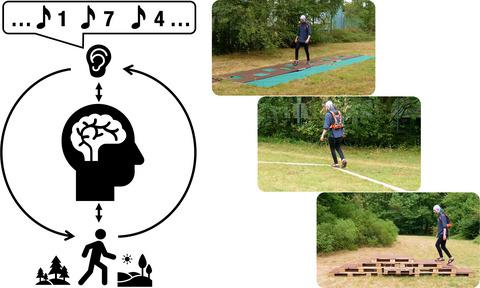当前位置:
X-MOL 学术
›
Eur. J. Neurosci.
›
论文详情
Our official English website, www.x-mol.net, welcomes your
feedback! (Note: you will need to create a separate account there.)
Cognitive-motor interference in the wild: Assessing the effects of movement complexity on task switching using mobile EEG
European Journal of Neuroscience ( IF 2.7 ) Pub Date : 2020-09-05 , DOI: 10.1111/ejn.14959 Julian E. Reiser 1 , Edmund Wascher 1 , Gerhard Rinkenauer 1 , Stefan Arnau 1
European Journal of Neuroscience ( IF 2.7 ) Pub Date : 2020-09-05 , DOI: 10.1111/ejn.14959 Julian E. Reiser 1 , Edmund Wascher 1 , Gerhard Rinkenauer 1 , Stefan Arnau 1
Affiliation

|
Adaptively changing between different tasks while in locomotion is a fundamental prerequisite of modern daily life. The cognitive processes underlying dual tasking have been investigated extensively using EEG. Due to technological restrictions, however, this was not possible for dual-task scenarios including locomotion. With new technological opportunities, this became possible and cognitive-motor interference can be studied, even in outside-the-lab environments. In the present study, participants carried out a cognitive-motor interference task as they responded to cued, auditory task-switch stimuli while performing locomotive tasks with increasing complexity (standing, walking, traversing an obstacle course). We observed increased subjective workload ratings as well as decreased behavioural performance for increased movement complexity and cognitive task difficulty. A higher movement load went along with a decrease of parietal P2, N2 and P3 amplitudes and frontal Theta power. A higher cognitive load, on the other hand, was reflected by decreased frontal CNV amplitudes. Additionally, a connectivity analysis using inter-site phase coherence revealed that higher movement as well as cognitive task difficulty had an impairing effect on fronto-parietal connectivity. In conclusion, subjective ratings, behavioural performance and electrophysiological results indicate that less cognitive resources were available to be deployed towards the execution of the cognitive task when in locomotion compared to standing still. Connectivity results also show a scarcity of attentional resources when switching a task during the highest movement complexity condition. Summarized, all findings indicate a central role of attentional control regarding cognitive-motor dual tasking and an inherent limitation of cognitive resources.
中文翻译:

野外认知运动干扰:使用移动脑电图评估运动复杂性对任务切换的影响
在运动中适应不同任务之间的变化是现代日常生活的基本先决条件。已经使用 EEG 广泛研究了双重任务背后的认知过程。然而,由于技术限制,这对于包括运动在内的双任务场景是不可能的。有了新的技术机会,这成为可能,即使在实验室外的环境中,也可以研究认知运动干扰。在本研究中,参与者在执行复杂性越来越高的机车任务(站立、行走、穿越障碍路线)时,在对线索、听觉任务切换刺激做出反应时,他们执行了认知运动干扰任务。我们观察到主观工作量评分增加以及行为表现降低,因为运动复杂性和认知任务难度增加。较高的运动负荷伴随着顶叶 P2、N2 和 P3 振幅和额叶 Theta 功率的降低。另一方面,较高的认知负荷反映为额叶 CNV 振幅降低。此外,使用站点间相位一致性的连接分析表明,较高的运动以及认知任务难度对额顶叶连接有损害作用。总之,主观评分、行为表现和电生理结果表明,与静止相比,在运动时可用于执行认知任务的认知资源更少。连通性结果还显示,在最高运动复杂性条件下切换任务时,注意力资源稀缺。总而言之,所有发现都表明注意力控制在认知-运动双重任务和认知资源的内在限制方面发挥着核心作用。
更新日期:2020-09-05
中文翻译:

野外认知运动干扰:使用移动脑电图评估运动复杂性对任务切换的影响
在运动中适应不同任务之间的变化是现代日常生活的基本先决条件。已经使用 EEG 广泛研究了双重任务背后的认知过程。然而,由于技术限制,这对于包括运动在内的双任务场景是不可能的。有了新的技术机会,这成为可能,即使在实验室外的环境中,也可以研究认知运动干扰。在本研究中,参与者在执行复杂性越来越高的机车任务(站立、行走、穿越障碍路线)时,在对线索、听觉任务切换刺激做出反应时,他们执行了认知运动干扰任务。我们观察到主观工作量评分增加以及行为表现降低,因为运动复杂性和认知任务难度增加。较高的运动负荷伴随着顶叶 P2、N2 和 P3 振幅和额叶 Theta 功率的降低。另一方面,较高的认知负荷反映为额叶 CNV 振幅降低。此外,使用站点间相位一致性的连接分析表明,较高的运动以及认知任务难度对额顶叶连接有损害作用。总之,主观评分、行为表现和电生理结果表明,与静止相比,在运动时可用于执行认知任务的认知资源更少。连通性结果还显示,在最高运动复杂性条件下切换任务时,注意力资源稀缺。总而言之,所有发现都表明注意力控制在认知-运动双重任务和认知资源的内在限制方面发挥着核心作用。











































 京公网安备 11010802027423号
京公网安备 11010802027423号